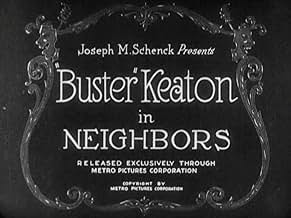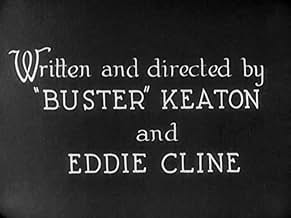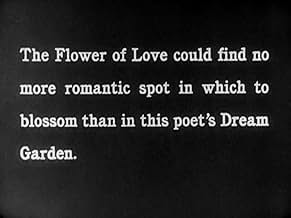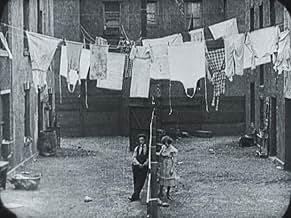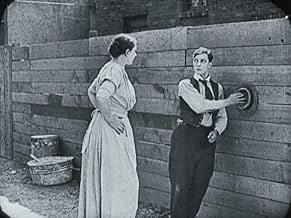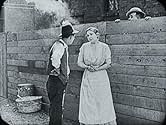PUNTUACIÓN EN IMDb
7,5/10
4,9 mil
TU PUNTUACIÓN
Añade un argumento en tu idiomaA young couple who live next to each other in tenement apartments do everything they can to be together despite of their feuding families.A young couple who live next to each other in tenement apartments do everything they can to be together despite of their feuding families.A young couple who live next to each other in tenement apartments do everything they can to be together despite of their feuding families.
- Dirección
- Guión
- Reparto principal
Edward F. Cline
- The Cop
- (sin acreditar)
Jack Duffy
- The Judge
- (sin acreditar)
The Flying Escalantes
- Themselves
- (sin acreditar)
Virginia Fox
- The Girl
- (sin acreditar)
Joe Keaton
- His Father
- (sin acreditar)
Joe Roberts
- Her Father
- (sin acreditar)
Reseñas destacadas
No, nothing to do with the Aussie soap opera. This "Neighbors"- I keep the original American spelling- is a silent comedy short from 1920. The plot is a comic take on the "Romeo and Juliet" story. Buster Keaton and Virginia Fox play young lovers who live in flats in adjoining buildings but whose families are constantly quarrelling with one another. Both families are, of course, hostile to the young people's relationship, and the film is the story of how Buster and Virginia overcome the obstacles to their love. (I use the names of the actors because we never find out the names of their characters. The cast-list simply refers to "The Boy" and "The Girl").
Modern rom-coms also often deal with how young couples deal with the obstacles to their love, but today such "obstacles" are generally metaphorical- not only parental disapproval but also things like differences in social class or a fear of commitment. This being a silent comedy, however, the obstacles in "Neighbors" can be literal, physical barriers such as a wooden fence separating the two properties and the fact that Virginia's bedroom is on the third floor. Buster has to use his acrobatic skills to overcome these barriers with circus-style stunts involving a trapeze and much balancing on top of ladders.
Films like this were a part of my childhood in the sixties and seventies because they were often shown on British television. I suspect that this was done to provide a nostalgic treat for my grandparents' generation, who would have remembered them from their youth, but they also proved popular with my own generation. My parents were both born in the thirties and, having grown up after the sound revolution, regarded silents as very old-fashioned, so I often ended up watching them with Grandma and Grandpa. I was certainly not alone among my schoolfriends in my enthusiasm for these old films; they were not expressly made as children's films, but there was obviously something about their physical style of humour which appealed to the young.
To the modern adult, this style of humour can seem as unsophisticated as it did to my parents; one of the gags, for example, involves Buster's trousers falling down during the wedding ceremony after his belt breaks. We have to remember, however, that the cinema of the 1910s and early 1920s was, of necessity, experimental. Silent acting, whether in comedy or serious drama, was something new, and film-makers could not rely upon the traditional skills of the theatre, where actors could speak. Pioneers like Keaton, who acted as co-writer and co-director of this film, had to be continually experimenting to find out what worked and what didn't. And in "Neighbors" he does sometimes succeed in making us laugh.
Modern rom-coms also often deal with how young couples deal with the obstacles to their love, but today such "obstacles" are generally metaphorical- not only parental disapproval but also things like differences in social class or a fear of commitment. This being a silent comedy, however, the obstacles in "Neighbors" can be literal, physical barriers such as a wooden fence separating the two properties and the fact that Virginia's bedroom is on the third floor. Buster has to use his acrobatic skills to overcome these barriers with circus-style stunts involving a trapeze and much balancing on top of ladders.
Films like this were a part of my childhood in the sixties and seventies because they were often shown on British television. I suspect that this was done to provide a nostalgic treat for my grandparents' generation, who would have remembered them from their youth, but they also proved popular with my own generation. My parents were both born in the thirties and, having grown up after the sound revolution, regarded silents as very old-fashioned, so I often ended up watching them with Grandma and Grandpa. I was certainly not alone among my schoolfriends in my enthusiasm for these old films; they were not expressly made as children's films, but there was obviously something about their physical style of humour which appealed to the young.
To the modern adult, this style of humour can seem as unsophisticated as it did to my parents; one of the gags, for example, involves Buster's trousers falling down during the wedding ceremony after his belt breaks. We have to remember, however, that the cinema of the 1910s and early 1920s was, of necessity, experimental. Silent acting, whether in comedy or serious drama, was something new, and film-makers could not rely upon the traditional skills of the theatre, where actors could speak. Pioneers like Keaton, who acted as co-writer and co-director of this film, had to be continually experimenting to find out what worked and what didn't. And in "Neighbors" he does sometimes succeed in making us laugh.
This is one of the few short films that was understated on the back on the DVD. Usually they make it sound better than it often winds up. Despite little buildup, this was tremendous fun for 18 minutes.
The very beginning is very innocent as Harold and Virginia Fox exchange love notes through a peephole in a fence that divides their family's tenement properties. Quickly, the parents of each come out, intercept the messages, disapprove, meddle further and then get involved in one wild and crazy scene after another. Featured are some terrific stunts and just general madness and mayhem with one funny sight gag after another. This is so frenetic that it has to be seen, not read about. Just be ready for a wild ride of feuding neighbors and cops.
It does calm down for a minute or two when a judge makes the parents sign a "peace treaty." Harold then announces he and Virginia are going to get married.....and they try to do that but, a combination of pants that won't stay up (don't ask) and Virginia's father, Big Joe Roberts, break that up. Now we go back to slapstick and clever scenes as Buster's friends help get his girl back. It's another crazy finish, albeit a short one.
It's very inventive stuff and one of Harold's best. It is an extra on the "Seven Chances" DVD. Note: Playing Buster's dad in here was his real-life father, Joe Keaton.
The very beginning is very innocent as Harold and Virginia Fox exchange love notes through a peephole in a fence that divides their family's tenement properties. Quickly, the parents of each come out, intercept the messages, disapprove, meddle further and then get involved in one wild and crazy scene after another. Featured are some terrific stunts and just general madness and mayhem with one funny sight gag after another. This is so frenetic that it has to be seen, not read about. Just be ready for a wild ride of feuding neighbors and cops.
It does calm down for a minute or two when a judge makes the parents sign a "peace treaty." Harold then announces he and Virginia are going to get married.....and they try to do that but, a combination of pants that won't stay up (don't ask) and Virginia's father, Big Joe Roberts, break that up. Now we go back to slapstick and clever scenes as Buster's friends help get his girl back. It's another crazy finish, albeit a short one.
It's very inventive stuff and one of Harold's best. It is an extra on the "Seven Chances" DVD. Note: Playing Buster's dad in here was his real-life father, Joe Keaton.
"Neighbors" is a very entertaining Buster Keaton short comedy featuring some hilarious slapstick and some good stunts. It takes place in a tenement complex, with Buster and Virginia Fox playing young lovers who live in buildings separated by a wooden fence. Their families don't like each other, and do what they can to undermine the romance, but without success. It's very funny right from the beginning, with Buster and Virginia slipping love notes through a knothole in the fence, and having them intercepted by one parent after another. There are lots of slapstick antics, and one of the funniest wedding scenes you will see. There are also some good stunts and brief chase scenes - in other words, a little bit of everything that Keaton was known for. It would probably be best appreciated by those who are already fans, but if you enjoy Keaton, don't miss this one.
Being one of Keaton's earliest and most recognised short film, Neighbours is full of passion, fast-paced, frantic and at times even romantically touching. It's innocent, light-hearted and airy, and just about sums up Buster's earliest work, going from slapstick nonsense to refreshing (for the time) character-driven gags that deliver just as well. Sure enough the feature is not without its drawbacks which do hinder the overall pacing and breezy feeling present in the short's best moments. Much like The Balloonatic, the greatest parts here lie in acts one and three, with the middle section giving way to fine moments of zany antics, but with plenty of superfluous additions to boot.
The plot here follows a young man and woman madly in love as they attempt to bring themselves together against their begrudging families. What follows is a piece of hilarious and wild twenty minute entertainment full of laughs and great images. Keaton himself is truly captivating as always, and delivers some of his most inspired and tricky stunts here which do well to thrill and bring up a laugh or two out of the sheer spectacle of what is going on. Throw in a beautiful supporting actress, and a whole host of very vivid personalities backing Buster, plus troublesome trousers, quarrelling families and you have a film that is sure to stick with you, despite its obvious inconsistencies and less successful moments.
For more of my reviews, please visit here: http://www.invocus.net
The plot here follows a young man and woman madly in love as they attempt to bring themselves together against their begrudging families. What follows is a piece of hilarious and wild twenty minute entertainment full of laughs and great images. Keaton himself is truly captivating as always, and delivers some of his most inspired and tricky stunts here which do well to thrill and bring up a laugh or two out of the sheer spectacle of what is going on. Throw in a beautiful supporting actress, and a whole host of very vivid personalities backing Buster, plus troublesome trousers, quarrelling families and you have a film that is sure to stick with you, despite its obvious inconsistencies and less successful moments.
For more of my reviews, please visit here: http://www.invocus.net
A BUSTER KEATON Silent Short.
Buster's romance with the pretty girl across the back fence leads to great trouble with the NEIGHBORS.
Keaton's superb athletic abilities are highlighted in this very funny little film. The backs of the tenement houses were constructed to Buster's exact physical specifications, giving him hand & foot holds precisely where he would need them, allowing him to climb, slide, cling, tumble, etc., culminating in the hilarious three-man high stunts that climax the film. Big Joe Roberts plays the beefy papa of Buster's beloved.
Born into a family of Vaudevillian acrobats, Buster Keaton (1895-1966) mastered physical comedy at a very early age. An association with Fatty Arbuckle led to a series of highly imaginative short subjects and classic, silent feature-length films - all from 1920 to 1928. Writer, director, star & stuntman - Buster could do it all and his intuitive genius gave him almost miraculous knowledge as to the intricacies of film making and of what it took to please an audience. More akin to Fairbanks than Chaplin, Buster's films were full of splendid adventure, exciting derring-do and the most dangerous physical stunts imaginable. His theme of a little man against the world, who triumphs through bravery & ingenuity, dominates his films. Through every calamity & disaster, Buster remained the Great Stone Face, a stoic survivor in a universe gone mad.
In the late 1920's Buster was betrayed by his manager/brother-in-law and his contract was sold to MGM, which proceeded to nearly destroy his career. Teamed initially with Jimmy Durante and eventually allowed small roles in mediocre comedies, Buster was for 35 years consistently given work far beneath his talent. Finally, before lung cancer took him at age 70, he had the satisfaction of knowing that his classic films were being rediscovered. Now, well past his centenary, Buster Keaton is routinely recognized & appreciated as one of cinema's true authentic geniuses. And he knew how to make people laugh...
Buster's romance with the pretty girl across the back fence leads to great trouble with the NEIGHBORS.
Keaton's superb athletic abilities are highlighted in this very funny little film. The backs of the tenement houses were constructed to Buster's exact physical specifications, giving him hand & foot holds precisely where he would need them, allowing him to climb, slide, cling, tumble, etc., culminating in the hilarious three-man high stunts that climax the film. Big Joe Roberts plays the beefy papa of Buster's beloved.
Born into a family of Vaudevillian acrobats, Buster Keaton (1895-1966) mastered physical comedy at a very early age. An association with Fatty Arbuckle led to a series of highly imaginative short subjects and classic, silent feature-length films - all from 1920 to 1928. Writer, director, star & stuntman - Buster could do it all and his intuitive genius gave him almost miraculous knowledge as to the intricacies of film making and of what it took to please an audience. More akin to Fairbanks than Chaplin, Buster's films were full of splendid adventure, exciting derring-do and the most dangerous physical stunts imaginable. His theme of a little man against the world, who triumphs through bravery & ingenuity, dominates his films. Through every calamity & disaster, Buster remained the Great Stone Face, a stoic survivor in a universe gone mad.
In the late 1920's Buster was betrayed by his manager/brother-in-law and his contract was sold to MGM, which proceeded to nearly destroy his career. Teamed initially with Jimmy Durante and eventually allowed small roles in mediocre comedies, Buster was for 35 years consistently given work far beneath his talent. Finally, before lung cancer took him at age 70, he had the satisfaction of knowing that his classic films were being rediscovered. Now, well past his centenary, Buster Keaton is routinely recognized & appreciated as one of cinema's true authentic geniuses. And he knew how to make people laugh...
¿Sabías que...?
- CuriosidadesIncluded in "Buster Keaton: The Shorts Collection" blu-ray set, released by Kino.
- Citas
His Father: He's my son and I'll break his neck any way I please!
- ConexionesEdited into The Golden Age of Buster Keaton (1979)
Selecciones populares
Inicia sesión para calificar y añadir a tu lista para recibir recomendaciones personalizadas
Detalles
- Duración18 minutos
- Mezcla de sonido
- Relación de aspecto
- 1.33 : 1
Contribuir a esta página
Sugerir un cambio o añadir el contenido que falta

Principal laguna de datos
By what name was Keaton en Vecinos (1920) officially released in Canada in English?
Responde
